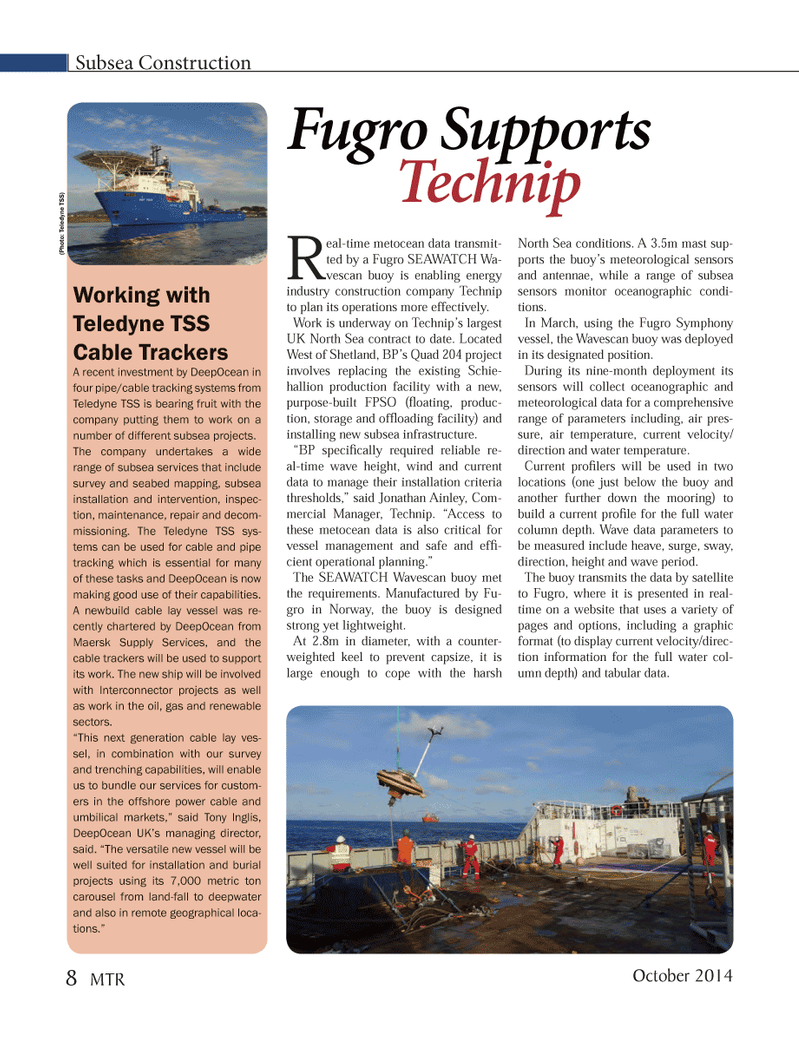
Page 8: of Marine Technology Magazine (October 2014)
Subsea Defense
Read this page in Pdf, Flash or Html5 edition of October 2014 Marine Technology Magazine
Subsea Construction Working with Teledyne TSS Cable Trackers A recent investment by DeepOcean in four pipe/cable tracking systems from Teledyne TSS is bearing fruit with the company putting them to work on a number of different subsea projects. The company undertakes a wide range of subsea services that include survey and seabed mapping, subsea installation and intervention, inspec- tion, maintenance, repair and decom- missioning. The Teledyne TSS sys- tems can be used for cable and pipe tracking which is essential for many of these tasks and DeepOcean is now making good use of their capabilities.A newbuild cable lay vessel was re- cently chartered by DeepOcean from Maersk Supply Services, and the cable trackers will be used to support its work. The new ship will be involved with Interconnector projects as well as work in the oil, gas and renewable sectors. ?This next generation cable lay ves- sel, in combination with our survey and trenching capabilities, will enable us to bundle our services for custom- ers in the offshore power cable and umbilical markets,? said Tony Inglis, DeepOcean UK?s managing director, said. ?The versatile new vessel will be well suited for installation and burial projects using its 7,000 metric ton carousel from land-fall to deepwater and also in remote geographical loca- tions.?Real-time metocean data transmit-ted by a Fugro SEAWATCH Wa- vescan buoy is enabling energy industry construction company Technip to plan its operations more effectively. Work is underway on Technip?s largest UK North Sea contract to date. Located West of Shetland, BP?s Quad 204 project involves replacing the existing Schie- hallion production facility with a new, purpose-built FPSO ( oating, produc- tion, storage and of oading facility) and installing new subsea infrastructure. ?BP speci cally required reliable re- al-time wave height, wind and current data to manage their installation criteria thresholds,? said Jonathan Ainley, Com- mercial Manager, Technip. ?Access to these metocean data is also critical for vessel management and safe and ef -cient operational planning.? The SEAWATCH Wavescan buoy met the requirements. Manufactured by Fu- gro in Norway, the buoy is designed strong yet lightweight. At 2.8m in diameter, with a counter- weighted keel to prevent capsize, it is large enough to cope with the harsh North Sea conditions. A 3.5m mast sup- ports the buoy?s meteorological sensors and antennae, while a range of subsea sensors monitor oceanographic condi-tions.In March, using the Fugro Symphony vessel, the Wavescan buoy was deployed in its designated position. During its nine-month deployment its sensors will collect oceanographic and meteorological data for a comprehensive range of parameters including, air pres-sure, air temperature, current velocity/ direction and water temperature. Current pro lers will be used in two locations (one just below the buoy and another further down the mooring) to build a current pro le for the full water column depth. Wave data parameters to be measured include heave, surge, sway, direction, height and wave period. The buoy transmits the data by satellite to Fugro, where it is presented in real-time on a website that uses a variety of pages and options, including a graphic format (to display current velocity/direc- tion information for the full water col- umn depth) and tabular data. (Photo: Teledyne TSS) Fugro Supports Technip October 20148 MTRMTR #8 (1-17).indd 8MTR #8 (1-17).indd 810/13/2014 11:16:17 AM10/13/2014 11:16:17 AM

 7
7

 9
9
